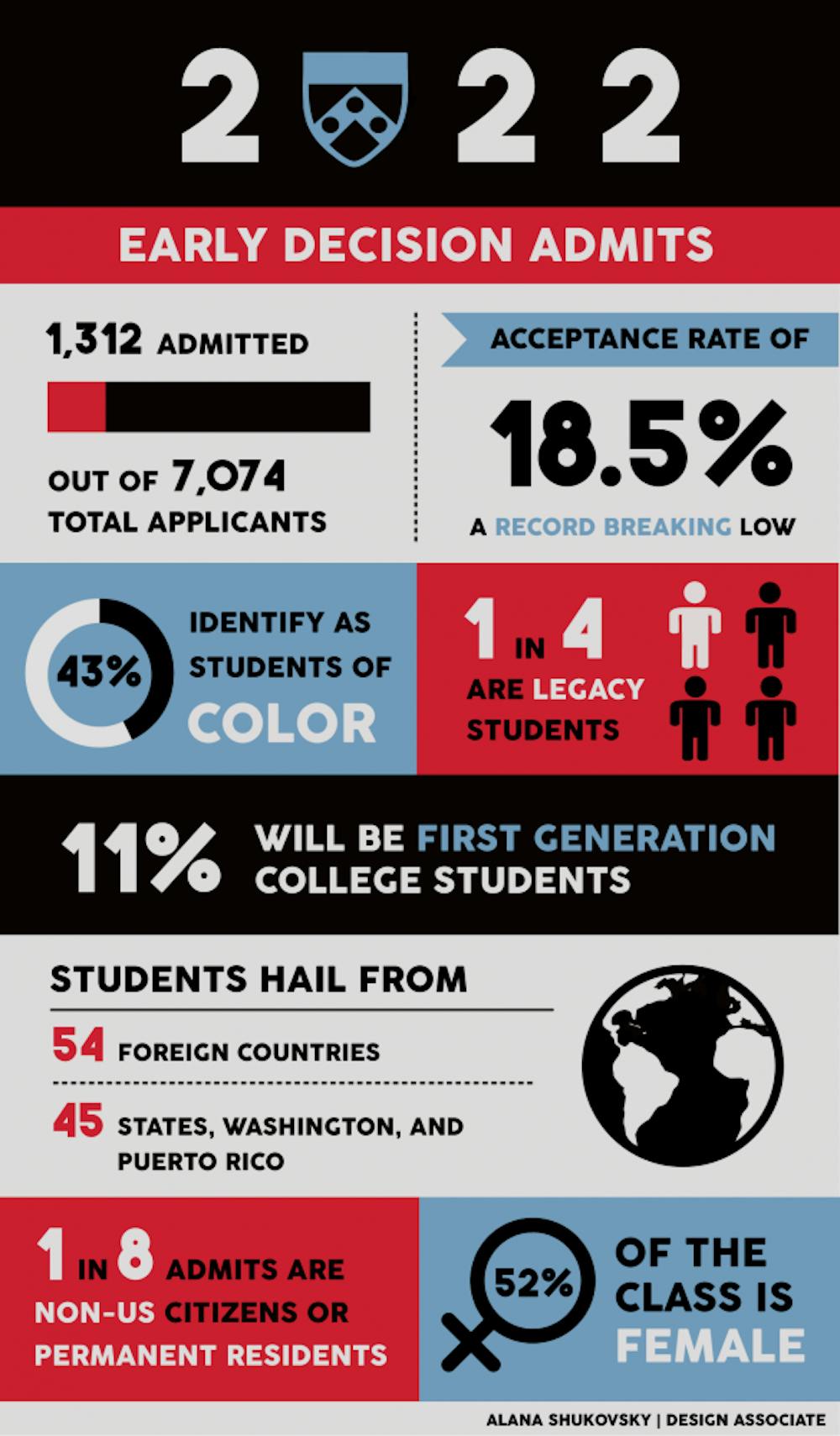
Penn admitted 18.5 percent of its early decision applicants for the Class of 2022, a dramatic drop from last year's 22 percent ED rate and the previous year's 23.2 percent rate.
Penn also received a record-breaking 7,074 early decision applications this year, a 15 percent increase from last year's 6,147 ED applicants. Since the Class of 2018 applied, the early decision application pool has grown by 38 percent, according to a press release from Penn Admissions.
Of those accepted this year, 25 percent had a parent or grandparent who had attended Penn, as opposed to the 16 percent of legacy applications received in November. Eleven percent of accepted students are first-generation college students, which is consistent with the percentage of first-generation applications received this year.
From this year's applicant pool, 1,312 were admitted, which is similar to the 1,354 applications admitted last year. Penn typically admits around half of its total class in the ED round. Last year, approximately 55 percent of the total 2,445 spots available were filled by early decision applicants.
The drop in the ED rate this year largely results from the increase in applications received, rather than a decrease in the number of applications accepted, based on the data provided.
Twelve percent of students accepted this year are not United States citizens or permanent residents. There are representatives from 45 states, Washington D.C., Puerto Rico, and 54 foreign countries.
In an emailed statement, Dean of Admissions Eric Furda wrote that "it does not appear that travel bans and immigration legislation has impacted Penn's applicant pool."
He added that this year's admissions process was the first year the redesigned SAT test was accepted and the old SAT test was not. Last year, serving as a transition year, both tests were accepted, in addition to the ACT test.
"With changes to format and scoring instituted by The College Board in 2016, most students received higher scores on the rSAT than what they would have received in the older SAT format. The rSAT represents a significant change within the larger college application landscape that may have impacted college search, choice, and application behavior on the part of individual students,” Furda wrote in the statement.
The dramatic drop in the ED acceptance rate appears to not simply be a result of the rSAT, according to Brian Taylor, a managing director at the college consulting firm Ivy Coach.
"This is a record year in terms of admission rate being 18.5 percent," Taylor said. "I would give more credit to Eric Furda than he’s giving to himself. Every one of these schools is impacted by this SAT and they would all have better numbers, but Penn’s numbers are drastically better this year."

Incoming Wharton and College freshman Shyama Dave, who was accepted early into the Huntsman Program in International Studies and Business, said that she much preferred the rSAT than the previous version.
"I actually took the old one in ninth grade and [the rSAT] was way better than the old one because the old one had a lot of obscure vocabulary which no one really uses outside of the SAT," Dave said. "But with the new one there wasn’t much — only vocabulary you should have seen through English class."
Incoming College freshman Abigail Metzler, who had never taken the old SAT, said that she took the rSAT only once and didn't think "it was too bad."
According to the Class of 2021's profile on the Penn Admissions website, however, the testing means for the middle 50 percent of admitted students for the old SAT reading and math sections were 710-790 and 740-800, respectively; means for the redesigned SAT reading and math sections were 680-750 and 690-770, respectively.
The testing breakdown for the Class of 2022 has not been released.
Correction: A previous version of this article stated that this was the first year the redesigned SAT was accepted. The article now reflects that this was the first year the redesigned SAT was accepted in place of the old SAT. The Daily Pennsylvanian regrets the error.
The Daily Pennsylvanian is an independent, student-run newspaper. Please consider making a donation to support the coverage that shapes the University. Your generosity ensures a future of strong journalism at Penn.
Donate




